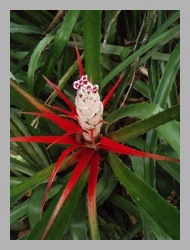Bromelia pinguin: Wild Pineapple
I took the picture above while out bicycling on a Christmas Day, 2008. But, didn’t identified the object de green until the next Thanksgiving.
Officially the United States Department of Agriculture says the Bromelia pinguin (bro-MEEL-ee-uh PIN-guin) does not grow in Florida, yet I have seen it thriving in four different untended places at least 130 miles apart, Mead Garden, West Orange Bike Trail at Ingram Road, Boulware Springs Gainesville and Colby Alderman Park southeast of Deland. What made it hard to identify was that it looked like three different plants. First guess was a Bromeliad. It also resembled a cactus, which did not help. It has stem spines pointing in two directions and I got several vicious wounds collecting samples. The fruit also looked like those of a pindo palm, but I was fairly sure it wasn’t a palm. All in all it was a conundrum.

Pineapple that doesn’t exist blossoming in April
After several false starts I was back where I started, in the Bromelaid family. It was a Bromelia pinguin. Then I ran into the usual language problem, but with a little twist. The larger family, Bromeliads, is named for Olaf Bromelius, a Swedish medical doctor and botanist. Bromelia, however, is from the Greek word meaning food, “broma.” Pinguin is from “penguis” Latin for stout or strong, a reference to using older leaves for cordage. While it is clever that the Bromelias are Bromeliads the names aren’t directly related. In Spanish its common name is pinuelo or pina salvaje. The natives called it karatas, and is often called wild pineapple. Many of the 48 different Bromelias have food uses.
Native to Central America it is cultivated and escaped in Florida, the Caribbean, Puerto Rico and Hawaii. It has long leathery leaves arching about a yard high and five feet long. They are usually about 120 degrees from each other forming a spiral around the plant. The leaves act like troughs directing water and nutrients down to the center of the plant where they are absorbed. The water stored there is so acidic it eats mosquitos, adding more food for the plant. The leaves have savage hooked, sharp spines that can point toward the base of the plant or away. Each plant produces 10 to 75 yellow fruit on a spike, each with 30 to 50 shiny black seeds. Besides man and other large mammals they are the favorite food of the red land crab, karatas.
The ripe fruit, which clings like Hercules to the stalk, can be eaten raw or cooked and is used to make a tart drink but see the caution below. I do not recommend eating it raw, or more specifically undiluted. The raw fruit can be extremely acidic and can burn the lip, tongue and throat. It needs to be diluted. The new leaves and flower stalks can be cooked like vegetables as can the flowers (with stinging hairs removed.) Medicinally the juice of the fruit has been employed for many uses from treating intestinal parasites, fevers, oral ulcers and to induce abortions. Older leaves fibers have been used to make cloth, fishing line, nets and string. A 100g sample of new growth is 92g water, 158 mg calcium, 50 mg phosphorus, 0.51 iron, 0.029 thiamine, 0.041 mg riboflavin, 0.382 niacin and 34 mg ascorbic acid. In Mexico the fruit are boiled and peeled before eating.
The fruits of the B. nidus-puellae, B. alta B. karatas, B. balansae, B. comosa B. plumieri, and B. chrysantha are also edible. The pineapple used to be in this genus.
One more note of caution: There might also be “meat tenderizer” in the juice of the Wild Pineapple. I know if I eat it my tongue and mouth feel fuzzy for a few hours, as if chemically shaved. But I also know people who can eat them without any oral effect. I recommend being careful with the plant from an edible point of view. Other Bromelias respond well to roasting.
Green Deane’s “Itemized” Plant Profile
IDENTIFICATION: A pineapple-like plant with large sword-shaped dark green leaves with alternating curved spines on their edge. It has many wooly red-orange flowers then elliptical yellow berries. The spines are vicious. Do not wade into a patch of Wild Pineapples.
TIME OF YEAR: Whenever in blossom or fruit. The plant flowers then fruits then dies
ENVIRONMENT: Prefers shade and well-drained soil.
METHOD OF PREPARATION: Flowers (stinging hairs removed) young shoots, stalk and core as a cooked vegetable. Fruits raw or cooked but I highly recommend not eating the fruit raw as it can be very acidic.


